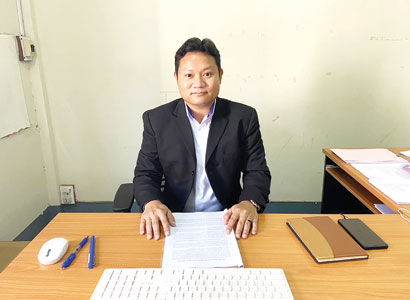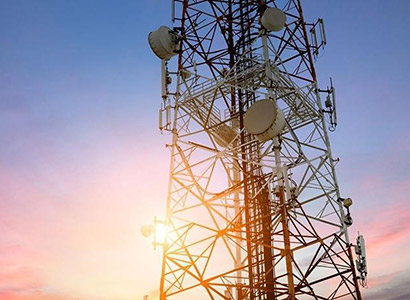Development of Lao telecoms and the future approach
For the past 18 months the Covid-19 pandemic has had a severe impact on everyone’s life.
However, we can agree that one of the responses to the pandemic has been to speed up the adoption of digital technologies and many changes made during this time that have brought a positive impact and will remain with us in the future.
With lockdowns and social distancing measures forcing many governments, businesses and schools to go online, the Covid-19 crisis has reinforced the importance of communication infrastructure and services, as well as access to information and data governance.
 |
| Deputy Director of the Information and Communication Technology Institute, Dr Padapxay Sayakhot. |
Addressing rural/urban digital divides in access to broadband and underserved socio-economic groups, upgrading networks to the next evolution of fixed and wireless broadband, and enhancing access to and the sharing of data can help spur economic and social benefits.
Regardless of how the crisis and its aftermath unfold, there is no doubt that digital technologies will continue to transform the way we live and work.
The emergence of 5Gand the Internet of Things will further fuel the production of big data. In this particular discussion, let’s review the development of the Lao telecommunications/ICT industry over the past 20 years and look at how far we have come and imagine what the future will bring to our country.
Lao telecommunication history, 2G, 3G, 4G developmentin the past 20 years
Laos has made a number of changes to the structure of its telecommunications sector over the past decade. This includes the introduction of private investment through joint ventures, which has contributed to the modernisation of telecommunication infrastructure. And with advanced technology development there are a number of leading vendors and suppliers of telecommunications equipment and services to operators in Laos, including the main solution provider – Huawei - which support telco providers’ telecommunication networks such as first 3G (2008) and 4G (2012) networks to serve people throughout the country.
Laos made impressive progress during the 1990s in boosting the fixed telephone network. An Advanced Mobile Phone System (AMPS) analogue cellular network was launched in 1993, serving Vientiane, and a year later the Global System for Mobile Communications (GSM) 900 Network was introduced in 1994.
Every successive generation of wireless standards – abbreviated to “G” – have introduced the advancement of data-carrying capacity and decreases in latency. To truly understand how we got here, it’s useful to chart the unstoppable rise of wireless standards from the first generation (1G) to where we are today, on the cusp of a global 5G rollout.
 |
When we recall the development of GSM, 2G was launched under the GSM standard services over the 900 MHz band. For the first time, calls could be encrypted and digital voice calls were significantly clearer with less static and background crackling.
But 2G was about much more than telecommunications; it helped lay the groundwork for nothing short of a cultural revolution. For the first time, people use the Short Message Service(SMS), send picture messages, and use the Multimedia Message Service (MMS) on their phones.
And in October 2009 came the launch of 3G - the Universal Mobile Telecommunications System (UMTS) service over the B1 (2100 MHz) band.
The 3G’s increased data transfer capabilities (4 times faster than 2G) also led to a rise in new services such as videoconferencing, video streaming and Voice over Internet Protocol (VoIP), such as Skype.
The 4G Long Term Evolution (LTE) network over the B3 (1800 MHz) band introduced in April 2015offers fast mobile web access (up to 1 gigabit per second for stationary users), which facilitates gaming services, High Definition (HD) videos and High Quality (HQ) video conferencing.
The ICT industry is becoming more and more crucial, and is changing more frequently, merging and integrating more with different industries
The world is more connected than ever, and the digital technology and technology revolution is evolving at an exponential rather than a linear pace.
It is disrupting almost every industry, such as logistics, commerce, health, education, and urban planning. And the breadth and depth of these changes has resulted in the transformation of entire systems of production, management, and governance.
ICT has become a key driver of social and economic development and will bring on board all the industries to be connected. ICT infrastructure and technology (including the national fiber backbone, 5G, Cloud, AI, block chain, big data, spectrum efficiency, digital green energy, etc.) will be the core engine of the Digital Economy.
The Digital Economy is here, and it will change the way people work, learn, shop, transact and interact amid global transformation.
While digitalisation continues to grow in unprecedented scope and ways and considerable progress has been made, Laos is catching up with digital adoption nationwide. Our priority strategy is adigital infrastructure upgrade, to create anenabling environment and ecosystem for ICT industry development and address the importance issues of digital literacy and digital skills.
More positive integration with the region’s main standards and ecosystems will be the right way for Laos, in terms of spectrum, cyber-security standards and many other industry standards.
The emergence of 5G, Cloud, AI, big data, and IoT will further fuel the production of data, adding urgency to ongoing policy discussions around data governance, privacy and security. As a policy maker re-evaluating existing digital policies in light of the Covid-19 crisis, we will surely face complex and inter-related issues that demand concerted international coordination, cooperation and dialogue through bilateral and regional cooperation, i.e., ASEAN and APT as well as through international agencies such as the International Telecommunication Union (ITU).
For spectrum standardisation, as we know spectrum is a scarce resource and we must carefully plan for efficient and optimal use (right now the average mobile broadband (MBB) user data consumption per month is already more than 20GB, twice the average in China and Europe, which means the stronger demand spectrum resource will be congested).
At the policy level, bilaterally, we have a joint coordination committee for spectrum management which meets annually to work together to ensure spectrum harmonisation and reduce frequency interference along the border, while at the regional level we have the ASEAN sub-working group of spectrum management and the Asia Pacific Telecommunity’s spectrum working group to coordinate frequency management at the regional level.
We have also work closely with the International Telecommunication Union, because spectrum harmonisation and standardisation must comply with international standards, especially with regard to frequency assignment and adoption.
Another important area is cyber security, because national data is very important and it’s impossible to fight cybercrime/attacks alone.
Therefore, we have worked closely with neighbouring countries and at the at regional level we have the ASEAN Network security working group to coordinate and work together on cyber policy development, share best practices, and exchange information relating to network security and cyber security issues.
5G is coming to Laos very soon. The right decision on 5G will be more integrated with ASEAN countries and existing major vendors (including Huawei)
When exploring what the next big thing will be, it comes down to the area being explored today, known as the Internet of Things. This is also related to the advent of 5G. With the promise of 5G capability, more and more broadband and intelligent devices will be connected, real time. This is not only about processing more data,but allowing seamless transactions to take place. As we have been informed, what stands out about 5G is the capability for enhanced mobile broadband, massive machine type communication, and ultra-reliable and low latency communications.
5G will come to Laos very soon. Now in ASEAN, 5 out of 10 countries have launched a 5G commercial network or plan to launch within this year. Laos started a 5G pilot (pre-commercial deployment)in collaboration with Huawei in late 2019. After almost two years of research and 5G device ecosystem development (the latest affordable smartphone almost supports 5G function), we believe that within the next year a commercial 5G network will be available in Laos (initially in the capital and some main cities).
Secure 5G communication technologies are also essential. In order to have a unified approach to cyber security in the telecoms industry, organisations like GSMA and 3GPP have also been working with industry stakeholders to formalise cyber security standards, such as NESAS Security Assurance Specifications and Independent certifications. These baselines have been widely recognised by the industry and will play an important role in the development and verification of secure networks. In March 2020, Huawei’s 5G RAN was the first to pass the GSMA NESAS audit. In May 2020, Huawei’s 5G core network was the first to pass the GSMA NESAS audit.
To consider the best 5G user experience, we have to look at global standard and ecosystem available options. Among the key prime spectrums to be considered is the C-Band spectrum (3.5GHz) for fundamental capacity and 700MHz spectrum for wide coverage. With a combination of both, operators can guarantee an excellent 5G experience, with 10 times data speed and 1/10 cost per GB compared to 4G technology.
By Advertorial Desk
(Latest Update September 9, 2021)
|